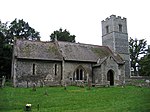Thetford Rural District
Districts of England created by the Local Government Act 1894Historical districts of NorfolkRural districts of EnglandUse British English from June 2017

Thetford Rural District was a rural district in Norfolk, England from 1894 to 1935.It was formed under the Local Government Act 1894 based on the Thetford rural sanitary district. It covered the lands which were in Norfolk and lay to the north and east of Thetford Municipal Borough. In 1902 it took in the western part of the disbanded Guiltcross Rural District,. In 1935, Thetford RD was abolished and its territory divided between Downham, Swaffham and Wayland RDs.
Excerpt from the Wikipedia article Thetford Rural District (License: CC BY-SA 3.0, Authors, Images).Thetford Rural District
Stump Buster, Breckland District Lynford
Geographical coordinates (GPS) Address Nearby Places Show on map
Geographical coordinates (GPS)
| Latitude | Longitude |
|---|---|
| N 52.48 ° | E 0.67 ° |
Address
Grime's Graves
Stump Buster
IP26 5DE Breckland District, Lynford
England, United Kingdom
Open on Google Maps









